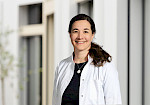Elevated liver values
Elevated liver values are often found in the blood by chance, e.g. during a check-up. Various diseases such as infections, alcohol overconsumption, obesity, medication and many more can be the cause of elevated liver values or liver disease. Through a detailed questioning of the patient and extended blood tests, a large part of the reasons can already be found. In addition to an interview and blood tests, an ultrasound of the abdomen is always performed to assess the liver and other structures (such as the spleen, blood circulation, etc.). A measurement of liver elasticity (Fibroscan ®) can also be used to assess liver stiffness, as this increases with increasing scarring (see liver cirrhosis). Sometimes a tissue sample (liver biopsy) is also needed to better assess the cause of the liver disease and its severity.
Hepatitis B
The hepatitis B virus infection can already be transmitted from the infected mother to the newborn during birth and often runs a chronic course. In adulthood, the virus is transmitted in non-vaccinated persons mainly during sexual intercourse and an acute inflammation of the liver often occurs, which can often heal completely. In the case of chronic infection, however, progressive liver damage can occur over the years (see cirrhosis of the liver). In addition, the risk of developing liver cancer (hepatocellular carcinoma, HCC) is increased to varying degrees.
6-monthly ultrasound examinations may be necessary. The virus can be suppressed with medication and thus the progression of liver damage can be prevented.
Hepatitis C
The hepatitis C virus is an infectious pathogen that is transmitted in particular through blood and in most cases leads to chronic inflammation of the liver. The chronic inflammation can go unnoticed for a long time or manifest itself with a variety of symptoms such as chronic fatigue or joint complaints. In about one fifth of those affected, scarring of the liver with its complications occurs after many years (see cirrhosis of the liver), which can be prevented by early treatment of the virus with medication (tablets). After a therapy period of 12 weeks on average, almost all those affected can be cured of the hepatitis C virus with modern medication.
Fatty liver
Fatty liver is the term used to describe increased fatty degeneration of the liver, which usually does not cause any noticeable symptoms. Increased liver values in the blood are often noticeable. Various causes can lead to increased fat storage in the liver, most frequently obesity, diabetes mellitus and dyslipidaemia, but also excessive alcohol consumption. In addition to a detailed questioning of the patient, blood analyses and ultrasound of the liver are important in order to find the cause of the fatty liver and to treat it accordingly. Untreated fatty liver inflammation that has been present for a long time leads to
In about 15% of those affected, cirrhosis of the liver develops after 15 years, with its possible complications.
Cirrhosis of the liver
Due to a wide variety of liver-damaging causes, over time the liver undergoes a scarring transformation, which in the advanced stages is called liver cirrhosis. This transformation causes the liver to become hard, making it difficult for blood to flow through the liver. This leads to various complications such as abdominal dropsy (called ascites), bleeding from the oesophagus (oesophageal varices) or an enlarged spleen (splenomegaly). In addition, the altered liver tissue has a greater tendency to develop liver cancer (hepatocellular carcinoma, HCC). To detect such changes early, patients should have 6-monthly ultrasound scans and also a gastroscopy to assess the risk of oesophageal bleeding.
Liver cancer
Liver cancer (hepatocellular carcinoma (HCC)) is a tumour that originates directly from the liver cells. Liver cancer must be clearly distinguished from the more frequent liver metastases in the context of other tumour diseases. The most important risk factor for HCC development is the presence of liver cirrhosis, the most common causes of which are chronic viral hepatitis B or C, chronic alcohol overconsumption and non-alcoholic fatty liver disease. Rarer causes are autoimmune hepatitis and hereditary liver diseases. All patients with liver cirrhosis should therefore receive HCC screening by means of liver ultrasound and determination of the tumour marker AFP in the blood every 6 months. If HCC is detected at an early stage, a cure can be sought by surgery or liver transplantation or local sclerotherapy (radiofrequency ablation). Often, however, patients cannot be treated with the aim of a cure due to an advanced stage or because the liver function is limited. For these patients, methods such as transarterial chemoembolisation (TACE) and treatment with drugs are possible with the aim of slowing down tumour growth.
Gallstones
Gallstones form when bile thickens and clumps together. In most cases, the gallstones settle in the gallbladder, where they never cause any symptoms in 75% of cases. In 25 % of patients, however, they cause symptoms such as pain in the right upper abdomen, sometimes severe colic, nausea and vomiting. If a gallstone obstructs the bile duct, jaundice, fever and possibly pancreatitis may occur. The best and a very simple way to detect gallstones is by ultrasound. Sometimes
magnetic resonance imaging (MRI-MRCP) or endosonography is also necessary. If there are gallstones in the gallbladder without symptoms, no therapy is necessary. Acute gallbladder inflammation is usually treated surgically by removing the gallbladder. If the bile ducts are blocked by gallstones, an endoscopy of the bile ducts (ERCP) must be performed, and the stones can usually be removed. Even if the gallstones have been removed from the bile ducts, the gallbladder should be surgically removed soon afterwards.



